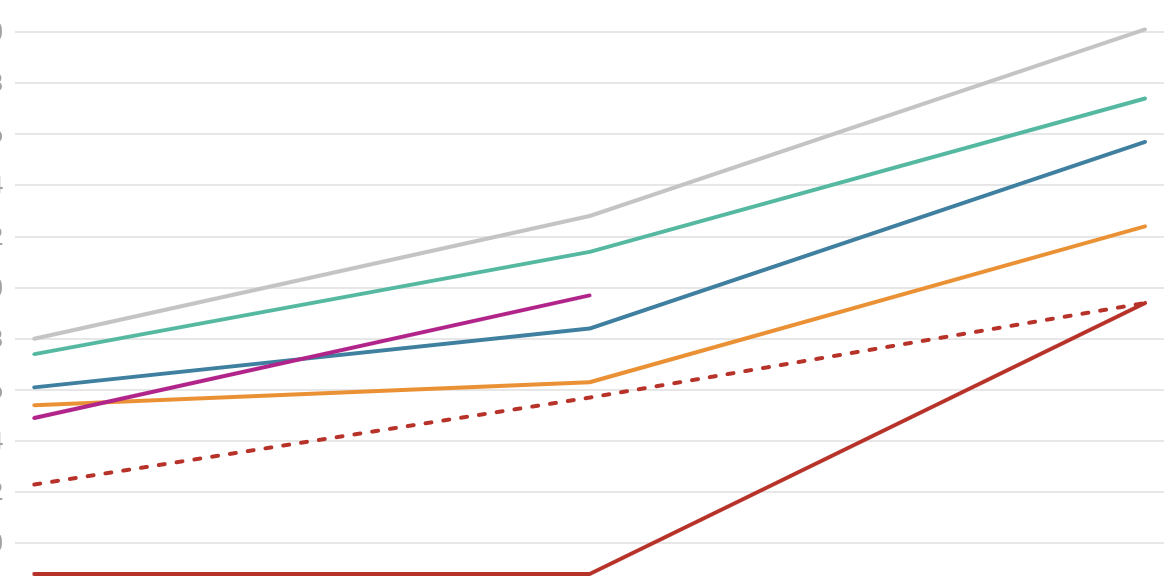As my final blog post about the 2023 NSW state election, I wanted to look back at how people cast their votes in 2023 – what method they used to vote, and how the results differed between those methods. I also touch on the different swings between different vote categories, and how this influenced the overestimation of Labor’s performance on election night.
As has been a consistent trend since the start of the COVID-19 pandemic, there was a significant drop in ordinary election day voting at this election.
Just over 50% of votes were cast at an ordinary election day booth, and another 6.4% were cast on election day outside the home electorate. That adds up to just over 57% cast on election day. This compares to over 92% at the 1999 election.
I wanted to assess how voting trends changed over the years, and the simplest voting measure is the two-party-preferred vote, whatever it’s flaws.
I have 2PP data at the booth level back to 2015, so it doesn’t cover as long a period, but this next chart shows Labor’s two-party-preferred vote by each vote type over the last three elections.
Labor was projected to win at least 47 seats late on election night, and even after that was revised down to 45 they were still leading in a number of others. But once large batches of pre-poll and postal votes were reported on Monday, Labor fell behind in pretty much every seat and were then on track for 45-46 seats.
At first I was a bit puzzled by the above chart, because the swing to Labor was actually pretty big on postal votes – up from 38.8% to 49.4%. Admittedly the pre-poll swing at 6.1% was less than the ordinary swing of 7.3%.
But then I realised that there was a substantial chunk of special votes which had vanished since 2019: 5% of votes were cast via iVote in 2019, and that vote category no longer exists. iVote was quite a strong category for Labor in 2019. If you merge it with postal voting, the swing for the combined category was less than 4%.
Indeed if you want to understand why the election-night projections were overoptimistic about Labor’s chances, looking at individual vote types is probably a distraction. It makes more sense just to look at election day votes (most of which were counted on the night) and other votes that were mostly counted later.
On that metric, Labor did 2% better on election day in 2015 and 2019, but did a whopping 3.7% better on election day in 2023.
And therein was the issue on election night. The early vote underperformed for Labor, and did so more than was expected.
If you’re interested in reading more, Antony Green has analysed this same topic, although that was before the final statewide two-party-preferred figures had been published. He runs through the individual close races and what changed their prediction in the days after the election.
This is my final blog post for the NSW state election. I may not post as much for the next little while but things will still be busy. I’ll be planning new episodes of the podcast, making submissions to post-election parliamentary inquiries, analysing the numerous redistributions on their way, and adding new datasets to the data repository.
If you find this work useful, now would be a good time to sign up to support the Tally Room on Patreon. I’ve had a small but noticeable decline in donations as we reach the end of this election season. Which is understandable, but the work doesn’t end. Thanks to everyone who is still signed up!




The postal vote swing being larger than the ordinary vote swing, could be because more Labor-leaning voters or those who were going to swing to Labor anyway, decided to vote by post. They probably voted ordinarily or via pre-poll in the past.
The AEC’s 2022 federal election stats show that in NSW, 3% were absent votes and 11% were postal votes. Anyone know why at the state election, absent votes more than doubled and postal votes went from 11% to 8.5%?
Has the increase in early voting also lead to an increase in the overall turnout?
No it hasn’t. Turnout (total votes/ enrolment) peaked at around 93% in 1999, 2007 and 2011, then dropped to 90.8% in 2015, 89.4% in 2019 and 88% in 2023.
But to be fair you’d want to factor in the total voter-eligible population. They have become more effective at enrolling people so the proportion of the eligible population on the roll has been rising. Thus if the turnout as a share of eligible population was steady, you’d expect the traditional turnout measure to go down. I don’t have the VEP numbers to hand at the moment.
Thanks for this series, Ben.
Many thanks Ben. My overall impression, not informed by data, is that the increase in prepolls has introduced considerably more uncertainty into the position at the end of election night. If the relationship between 2PP prepolls and election day votes was reasonably consistent election to election, then knowing in advance the proportion of prepolls, it should be possible to factor that into election night predictions with reasonable confidence. But in some elections (eg NSW 2023 and Vic 2018) the election day votes seemed to have a much higher relative ALP 2PP — so on election night the ALP looked much further ahead than they ended up being. In other elections that pattern doesn’t seem to have played out. Not sure if this impression is correct or not. If so it suggests we need to be much more careful with election night predictions or that where possible prepolls are counted more quickly.
Comments are closed.